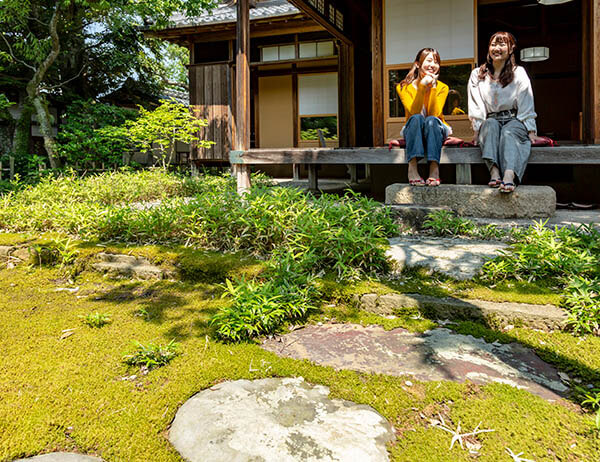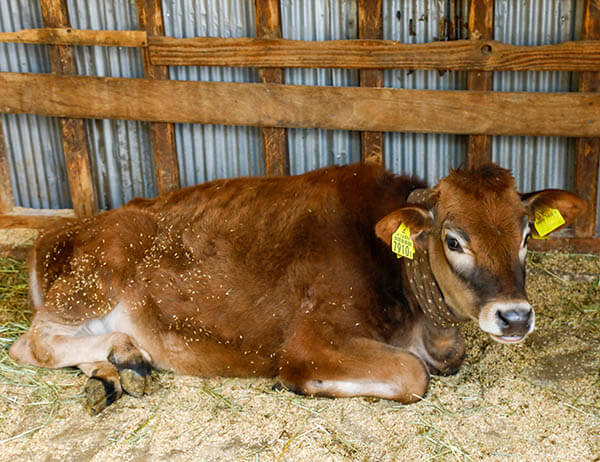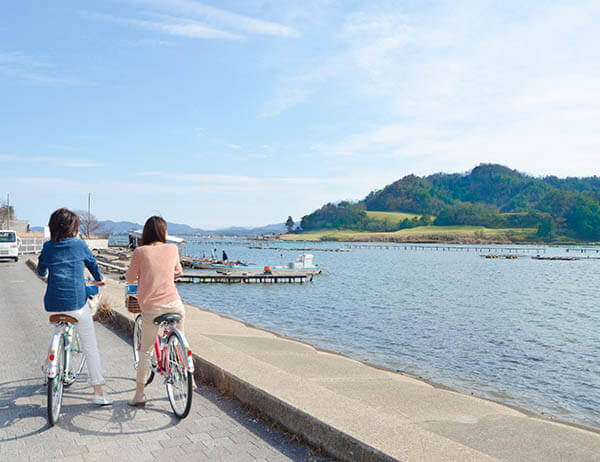

Find Great Food Touring Around Kumihama Bay
Find Great Food Touring Around Kumihama Bay
Take a ride through the quaint old towns that dot the bay, and get a feel for the area's long history.
See the Shotenkyo sand bar, that separates the bay from the sea, and the oyster farms, which grow fat in the plankton rich waters of Kumihama Bay.

Course Map
Rental Information
- Store Name
-
Kumihama Tourist Information CenterTourist Info. Desk Inside Kumihama Train Station - 772 Kumihama Town, Kyotango City
- Closed
- New Year's Period
- Open Hours
- 9:00am – 5:00pm
- Phone Number
- +81772 72 6070
- Fees
- Standard Bikes:
1 day / ¥400
Children's standard bikes available
Electric Assist Bikes:
1 day / ¥1,500 (Real Stream mini)/ ¥2,000 (Jetter)
*Must be 144cm or more to ride an electric bike
* For people around 145cm tall the bike's battery will last for about 3.5 hours of assisted riding
Electric Scooters:
30 mins/ ¥300
Payments for electric and standard bikes must be made in cash, electric scooter payments are card only - Rental Duration
- Opening Hours: 9:00am – 5:00pm
* Please make sure to return your bike within this timeframe, if not, a late fee of 1 additional day will be charged - No. of Bikes
- 8 Standard Bikes
3 Children's Bikes
4 Electric Assist Bikes*
4 Electric Scooters
*Electric Assist Bikes require advance booking
Bicycles with child seats are not available - Rental Method
- Please complete the rental form at the counter and provide some identification (passport, Japanese driver's license, health insurance card, student ID etc.)
- Other Comments
- Please note:
Standard bikes can also be returned to Kumihama Station, Hair & Face Otokoya (near Shotenkyo Station) or also to Shotenkyo Tourist Information Center. Electric Assist bikes & Scooters may only be returned to Kumihama Station.
E-bikes can be booked up until 5pm the day before the desired rental period
Start at Kumihama Train Station
Borrow a bike from the Tourist Information Desk inside Kumihama Train Station. They will give you everything you need to start on your cycle trip.
Business hours: 9am - 5pm
For full details click 'Rental Info' above.
POINT 1
Kamitani Shrine(Kamitani-tachinomiya)
This shrine has a long history, and is recorded in the Shinmeicho, 'Register of Shrines' from 927CE. It is the only shrine in the Kinki region that enshrines Taniwa no Michinushi-no-Mikoto, an important general in the area.
The shrine is called "Tachi-no-miya", which translates to "Sword Shrine", because it enshrines the treasured sword "Kunimi no Tsurugi".
There is also an ancient boulder that is believed to be the remains of an ancient solar ritual. There is a crack in the stone that was used to measure the summer solstice by the sun rising over Mt. Kabutoyama to the east. It's famous as a power-spot, where you can still feel the ancient energies.
POINT 2
Inaba Family Merchant House – Gosho Inaba Honke
This is the restored mansion of the Inaba family, who ran a shipping business in the Kumihama area during the Edo period (1603-1868). Starting with the production of rice malt, they went on to acquire great wealth through coastal trade.
The main building is 130 years old and is a nationally registered tangible cultural property. At the 200-year-old restaurant, Ginsho-sha, you can enjoy freshly made botamochi, sweet bean paste wrapped around chewy rice cakes, while gazing at the atmospheric garden created by a famous local gardener.
The "Postbox that Transcends Time and Space" is also popular. You can buy special postcards at the store and send them to the future: one year, three years, or five years from now.
POINT 3
Kumihama Park
The park is located in the south of Kumihama Bay and has a great sense of openness, with the calm bay spreading out in front of it. From here you can see two great Kumihama landmarks, Mt. Kabutoyama and Shotenkyo.
Spend some time relaxing on a park bench looking out over the bay, and try to find the picture of the cute flounder fish (see the pic below).
POINT 4
Kinoshita Brewery
The brewery of the famous Tamagawa sake, which has been around since 1838. Kinoshita brewery is also famous for its head-brewer, an English master brewer who carries on the traditional techniques of Japanese sake making.
At the in-brewery store you can buy products available all-year-round, and seasonal specialty products, as well as rare sake limited to the brewery. Either pick up something for later or we recommend the non-alcoholic local sake-flavored soft-serve ice cream. It has a sweet but refreshing taste.
*Japan has zero-tolerance for drink driving, even on bicycles.
POINT 5
Dairy Kitchen Sora
The shop sells ice cream, cheese, pudding and other handmade dairy products. It's all made with freshly squeezed, rich Jersey milk from the Tango Jersey Farm next door. The store also offers soft-serve ice cream and gelato made with seasonal ingredients from the local area.
Wood-fired pizza is served in the restaurant on weekends and holidays.
POINT 6
Kumihama SANKAIKAN (roadside station)
There is a wide variety of fresh, seasonal ingredients, including seasonal vegetables and fruits, grown with love by local farmers.
In the spring, you can find seaweed, in the summer small watermelons and muskmelons, in the fall pears and sweet potatoes grown in the dunes of the local beaches, and in the winter: oysters.
POINT 7
Shotenkyo
Shotenkyo is the sandbank that separates the Sea of Japan from Kumihama Bay. It has a long beach with shallow, clear water and beautiful white sand and green pine trees.
Looking towards Kumihama Bay, you can see the Kumihama oyster farms. On Shotenkyo there are hotels and ryokans lining the white sandy beaches. The beaches stretch all the way from Shotenkyo and Kazurano-hama Beach to Yuhigaura in the distant.
POINT 8
Minato Ohashi (Harbor Bridge)
This large bridge straddles the channel that leads from Kumihama Bay to the Sea of Japan. There is a tiny shrine on a small island under the bridge.
Just across from the Minato Ohashi 'large bridge' is the foot bridge called Minato Kobashi 'small bridge'. Looking as if it stretches off to heaven, it is also worth stopping off at on your course.
POINT 9
Nyoi-Ji Temple
Nyoiji Temple, the seventh temple of the "25 Kansai Flower Temples" has hundreds of different flowering trees and wildflowers blooming every year.
Around the temple grounds, about 10,000 mitsuba-tsutsuji 'three-leaved azaleas' grow wild and are at their best from early to mid-April.
The "flower sermon" by the chief priest is also one of the specialties of the temple.
POINT 10
The Spice
The restaurant is in a 3 storey wooden house built in the Taisho era. It used to be run as a restaurant and hotel by the owners grandparents.
Flavor presentation, customer service, interior, music, building and design are all types of spice. These all come together to make each dish special.
POINT 11







-1000x667.jpg)


























